Unsteady Mass Transfer in Bubble Wakes Analyzed by Lagrangian Coherent Structures in a Flat-Bed Reactor
Abstract
1. Introduction
2. Materials and Methods
2.1. Experimental Setup
2.1.1. Particle Image Velocimetry
2.1.2. LED-Induced Fluorescence
2.2. Lagrangian Methods
3. Results and Discussion
3.1. Concentration Fields in the Bubble Wakes
3.2. FTLE Fields
3.3. Comparison of the Concentration and bFTLE Fields
3.4. Approximate Identification of Liquid Transported into the Bubble Wake
4. Conclusions
Supplementary Materials
Author Contributions
Funding
Data Availability Statement
Acknowledgments
Conflicts of Interest
References
- Schlüter, M.; Bothe, D.; Herres-Pawlis, S.; Nieken, U. (Eds.) Reactive Bubbly Flows: Final Report of the DFG Priority Programm 1740; Fluid Mechanics and Its Applications; Springer: Cham, Switzerland, 2021; Volume 128. [Google Scholar]
- Kück, U.; Kröger, M.; Bothe, D.; Räbiger, N.; Schlüter, M.; Warnecke, H.J. Skalenübergreifende Beschreibung der Transportprozesse bei Gas/Flüssig-Reaktionen. Chem. Ing. Tech. 2011, 83, 1084–1095. [Google Scholar] [CrossRef]
- Hatta, S. On the absorption velocity of gases by liquids. Tech. Repts. Tohoku Imp. Univ. 1932, 10, 119–128. [Google Scholar]
- Baerns, M.; Hofmann, H.; Renken, A.; Falbe, J.; Fetting, F.; Keim, W.; Onken, U. Chemische Reaktionstechnik: Lehrbuch der Technischen Chemie; Wiley: Hoboken, NJ, USA, 1999; Volume 1. [Google Scholar]
- Koudella, C.R.; Neufeld, Z. Reaction front propagation in a turbulent flow. Phys. Rev. E Stat. Nonlinear Soft Matter Phys. 2004, 70, 026307. [Google Scholar] [CrossRef]
- Haller, G.; Yuan, G. Lagrangian coherent structures and mixing in two-dimensional turbulence. Phys. D Nonlinear Phenom. 2000, 147, 352–370. [Google Scholar] [CrossRef]
- Haller, G. Lagrangian Coherent Structures. Annu. Rev. Fluid Mech. 2015, 47, 137–162. [Google Scholar] [CrossRef]
- Shadden, S.C.; Lekien, F.; Marsden, J.E. Definition and properties of Lagrangian coherent structures from finite-time Lyapunov exponents in two-dimensional aperiodic flows. Phys. D Nonlinear Phenom. 2005, 212, 271–304. [Google Scholar] [CrossRef]
- Onu, K.; Huhn, F.; Haller, G. LCS Tool: A Computational Platform for Lagrangian Coherent Structures. J. Comput. Sci. 2015, 7, 26–36. [Google Scholar] [CrossRef]
- von Kameke, A.; Kastens, S.; Rüttinger, S.; Herres-Pawlis, S.; Schlüter, M. How coherent structures dominate the residence time in a bubble wake: An experimental example. Chem. Eng. Sci. 2019, 207, 317–326. [Google Scholar] [CrossRef]
- Kexel, F.; von Kameke, A.; Tenhaus, J.; Hoffmann, M.; Schlüter, M. Taylor Bubble Study of the Influence of Fluid Dynamics on Yield and Selectivity in Fast Gas–Liquid Reactions. Chem. Ing. Tech. 2021, 93, 830–837. [Google Scholar] [CrossRef]
- Kastens, S.; Timmermann, J.; Strassl, F.; Rampmaier, R.F.; Hoffmann, A.; Herres-Pawlis, S.; Schlüter, M. Test System for the Investigation of Reactive Taylor Bubbles. Chem. Eng. Technol. 2017, 40, 1494–1501. [Google Scholar] [CrossRef]
- Kexel, F.; Kameke, A.V.; Hoffmann, M.; Schlüter, M. The influence of fluid dynamics on the selectivity of fast gas–liquid reactions in methanol. Chem. Eng. Process.—Process Intensif. 2021, 180, 108650. [Google Scholar] [CrossRef]
- Roig, V.; Roudet, M.; Risso, F.; Billet, A.M. Dynamics of a high-Reynolds-number bubble rising within a thin gap. J. Fluid Mech. 2012, 707, 444–466. [Google Scholar] [CrossRef]
- Kopf-Sill, A.R.; Homsy, G.M. Bubble motion in a Hele–Shaw cell. Phys. Fluids 1988, 31, 18–26. [Google Scholar] [CrossRef]
- Wang, X.; Klaasen, B.; Degrève, J.; Blanpain, B.; Verhaeghe, F. Experimental and numerical study of buoyancy-driven single bubble dynamics in a vertical Hele-Shaw cell. Phys. Fluids 2014, 26, 123303. [Google Scholar] [CrossRef]
- Filella, A.; Ern, P.; Roig, V. Oscillatory motion and wake of a bubble rising in a thin-gap cell. J. Fluid Mech. 2015, 778, 60–88. [Google Scholar] [CrossRef]
- Schanz, D.; Gesemann, S.; Schröder, A. Shake-The-Box: Lagrangian particle tracking at high particle image densities. Exp. Fluids 2016, 57, 70. [Google Scholar] [CrossRef]
- Pavlov, L.; Cazin, S.; Ern, P.; Roig, V. Exploration by Shake-the-Box technique of the 3D perturbation induced by a bubble rising in a thin-gap cell. Exp. Fluids 2021, 62, 22. [Google Scholar] [CrossRef]
- Roudet, M.; Billet, A.M.; Cazin, S.; Risso, F.; Roig, V. Experimental investigation of interfacial mass transfer mechanisms for a confined high–reynolds–number bubble rising in a thin gap. AIChE J. 2017, 63, 2394–2408. [Google Scholar] [CrossRef]
- Felis, F.; Strassl, F.; Laurini, L.; Dietrich, N.; Billet, A.M.; Roig, V.; Herres-Pawlis, S.; Loubière, K. Using a bio-inspired copper complex to investigate reactive mass transfer around an oxygen bubble rising freely in a thin-gap cell. Chem. Eng. Sci. 2019, 207, 1256–1269. [Google Scholar] [CrossRef]
- Huang, J.; Saito, T. Discussion about the differences in mass transfer, bubble motion and surrounding liquid motion between a contaminated system and a clean system based on consideration of three-dimensional wake structure obtained from LIF visualization. Chem. Eng. Sci. 2017, 170, 105–115. [Google Scholar] [CrossRef]
- Ouellette, N.T.; O’Malley, P.J.J.; Gollub, J.P. Transport of Finite-Sized Particles in Chaotic Flow. Phys. Rev. Lett. 2008, 101, 174504. [Google Scholar] [CrossRef]
- Chen, J.; Kim, H.D.; Kim, K.C. Measurement of dissolved oxygen diffusion coefficient in a microchannel using UV-LED induced fluorescence method. Microfluid. Nanofluid 2013, 14, 541–550. [Google Scholar] [CrossRef]
- Rüttinger, S.; Spille, C.; Hoffmann, M.; Schlüter, M. Laser-Induced Fluorescence in Multiphase Systems. ChemBioEng Rev. 2018, 5, 253–269. [Google Scholar] [CrossRef]
- Jimenez, M.; Dietrich, N.; Grace, J.R.; Hébrard, G. Oxygen mass transfer and hydrodynamic behaviour in wastewater: Determination of local impact of surfactants by visualization techniques. Water Res. 2014, 58, 111–121. [Google Scholar] [CrossRef]
- Timmermann, J. Experimental Analysis of Fast Reactions in Gas-Liquid Flows, 1st ed.; Berichte aus dem Institut für Mehrphasenströmungen; Cuvillier Verlag: Göttingen, Germany, 2018; Volume 3. [Google Scholar]
- von Kameke, A.; Kexel, F.; Ruttinger, S.; Colombi, R.; Kastens, S.; Schluter, M. 3D-reconstruction of O2 bubble wake concentration fields. In Proceedings of the 13th International Symposium on Particle Image Velocimetry—ISPIV 2019, Munich, Germany, 22–24 July 2019. [Google Scholar]
- Sato, T.; Hamada, Y.; Sumikawa, M.; Araki, S.; Yamamoto, H. Solubility of Oxygen in Organic Solvents and Calculation of the Hansen Solubility Parameters of Oxygen. Ind. Eng. Chem. Res. 2014, 53, 19331–19337. [Google Scholar] [CrossRef]
- Padberg-Gehle, K.; Schneide, C. Network-based study of Lagrangian transport and mixing. Nonlinear Process. Geophys. 2017, 24, 661–671. [Google Scholar] [CrossRef]
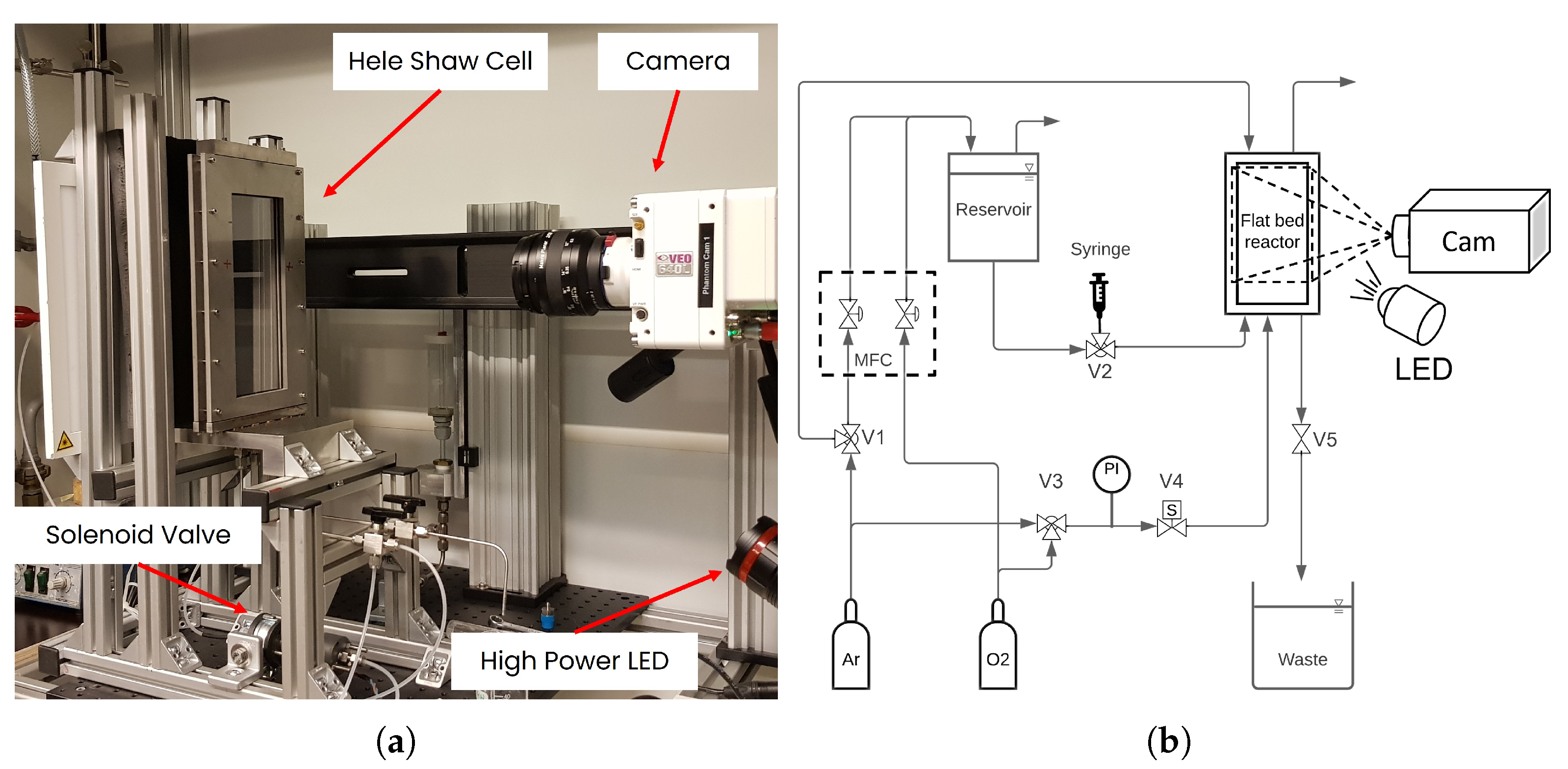
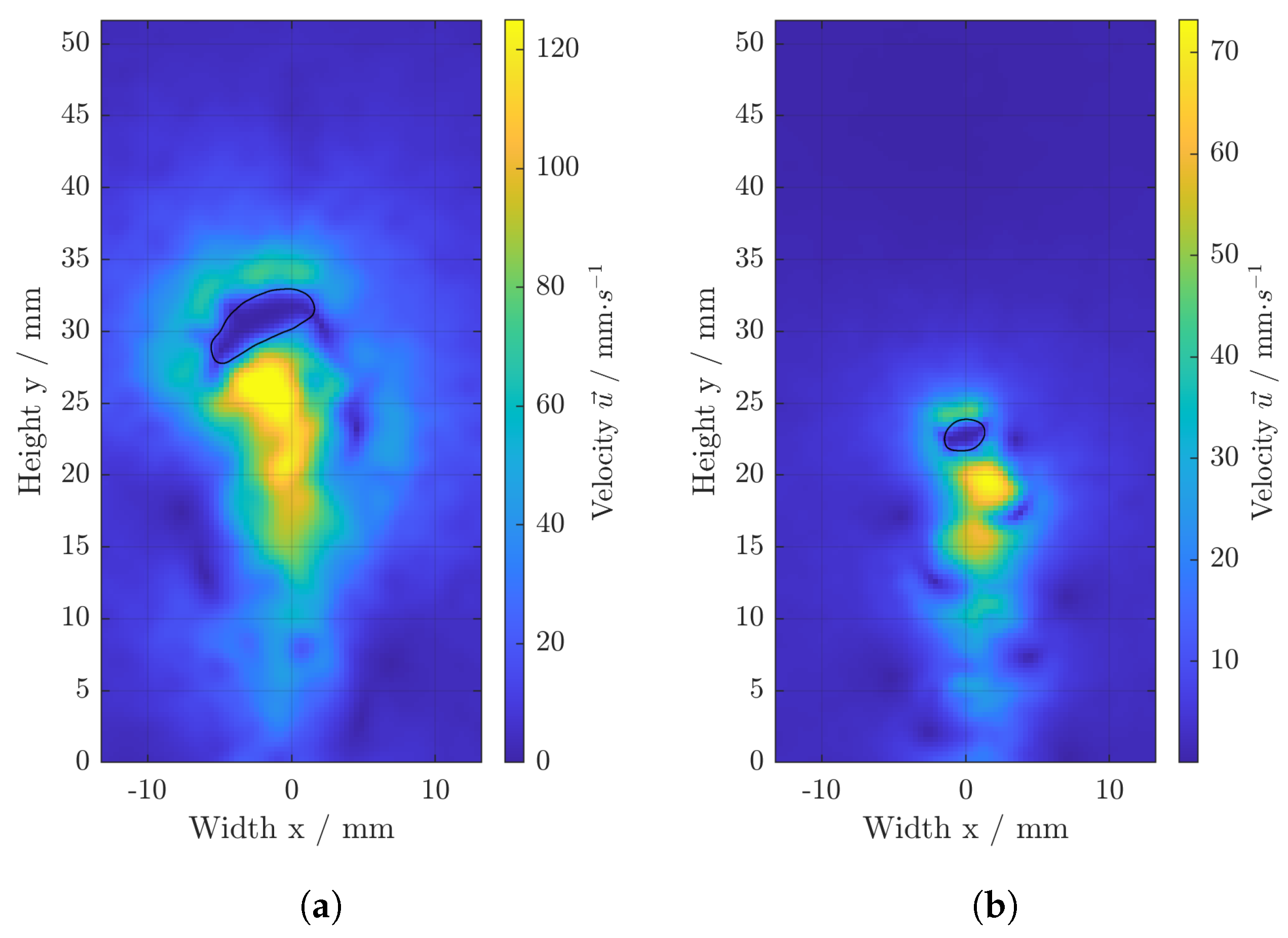
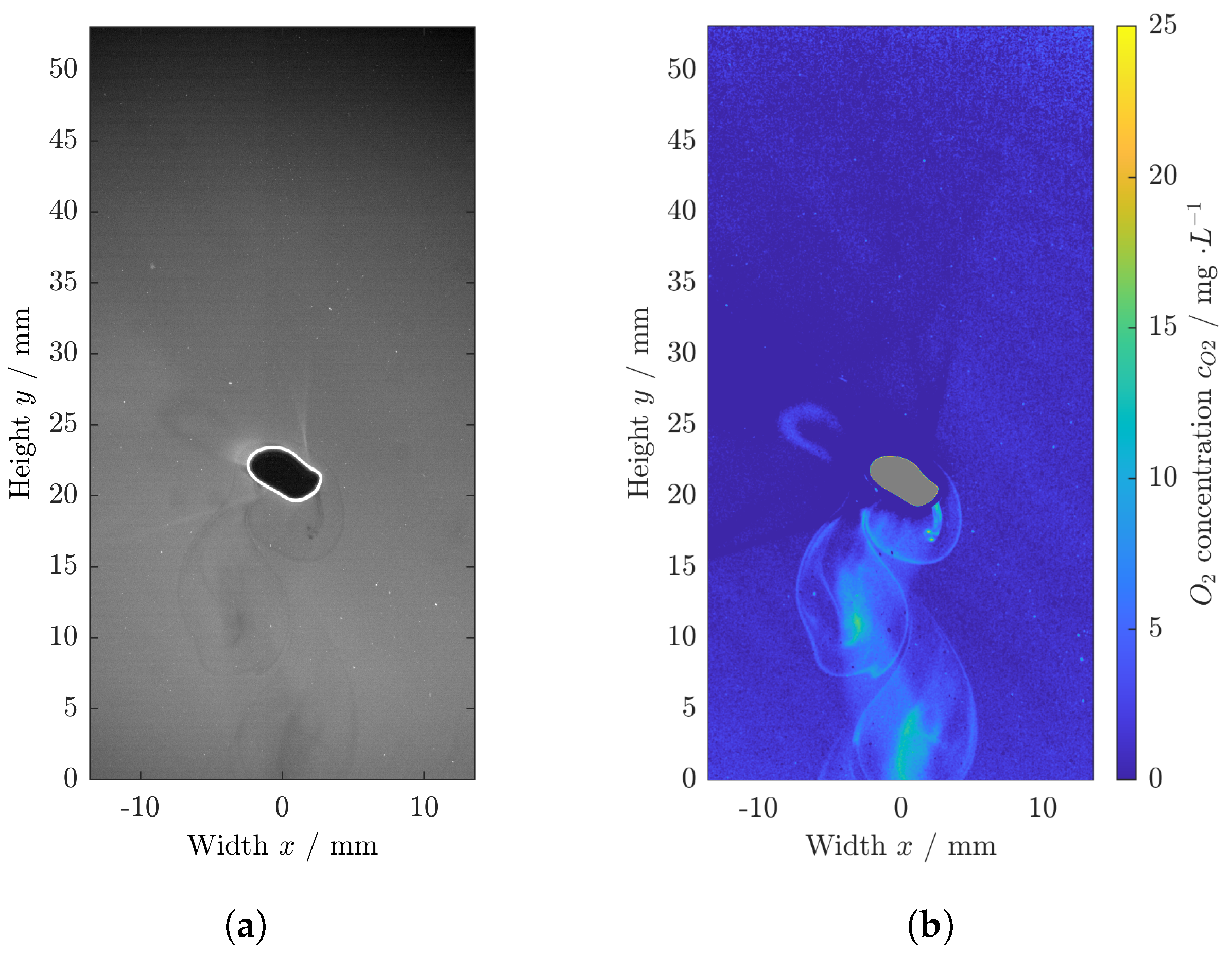


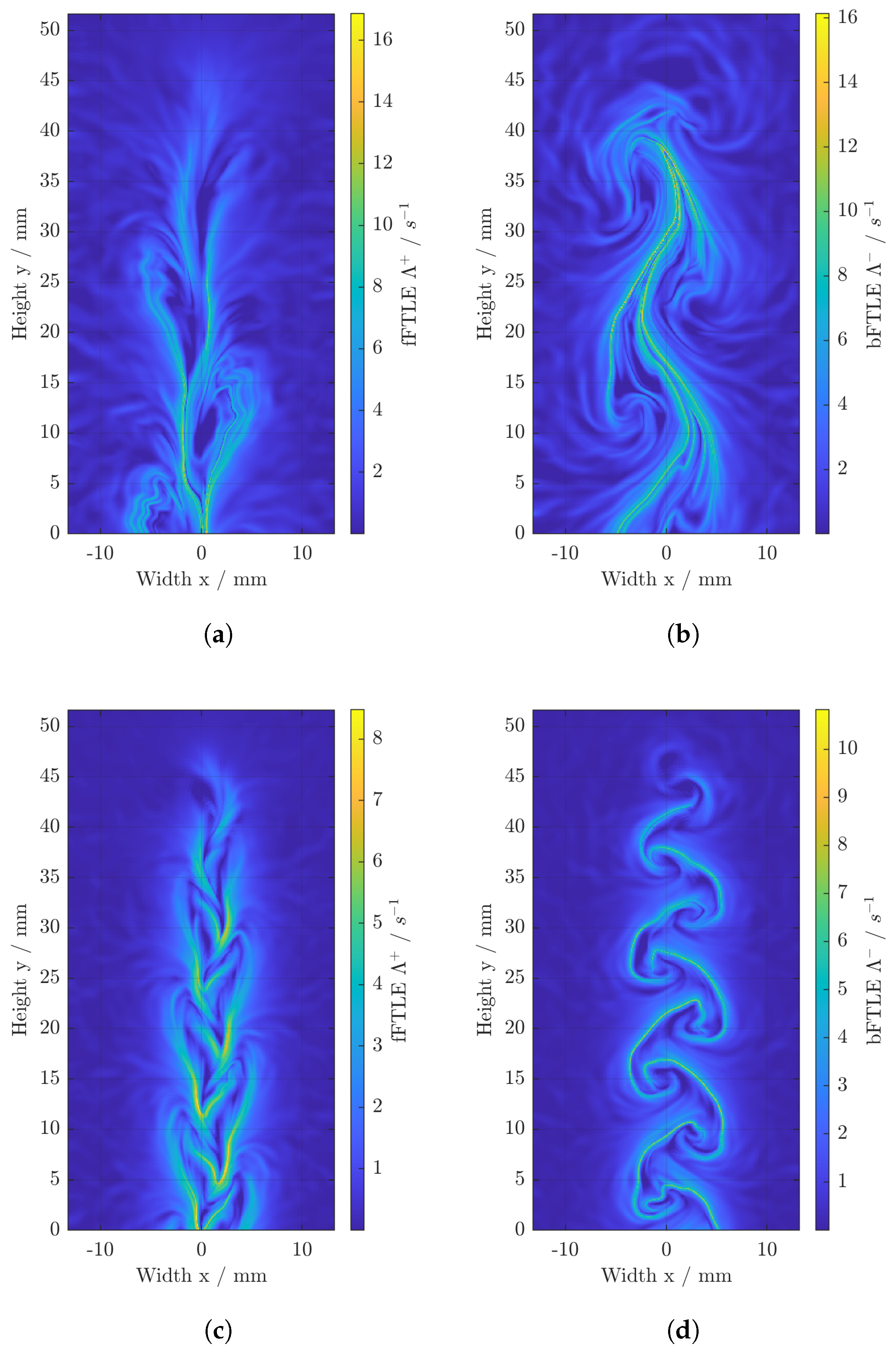
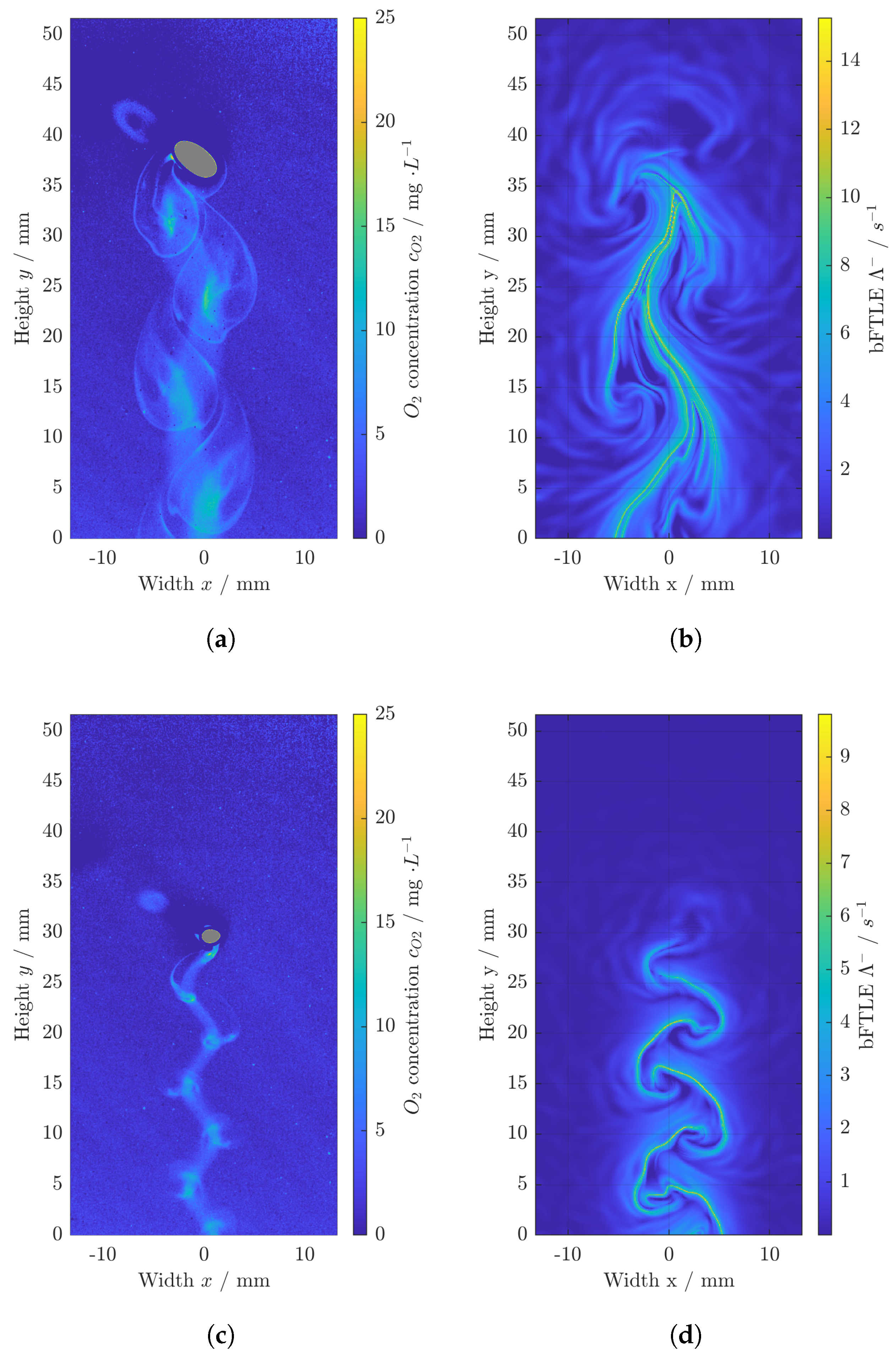
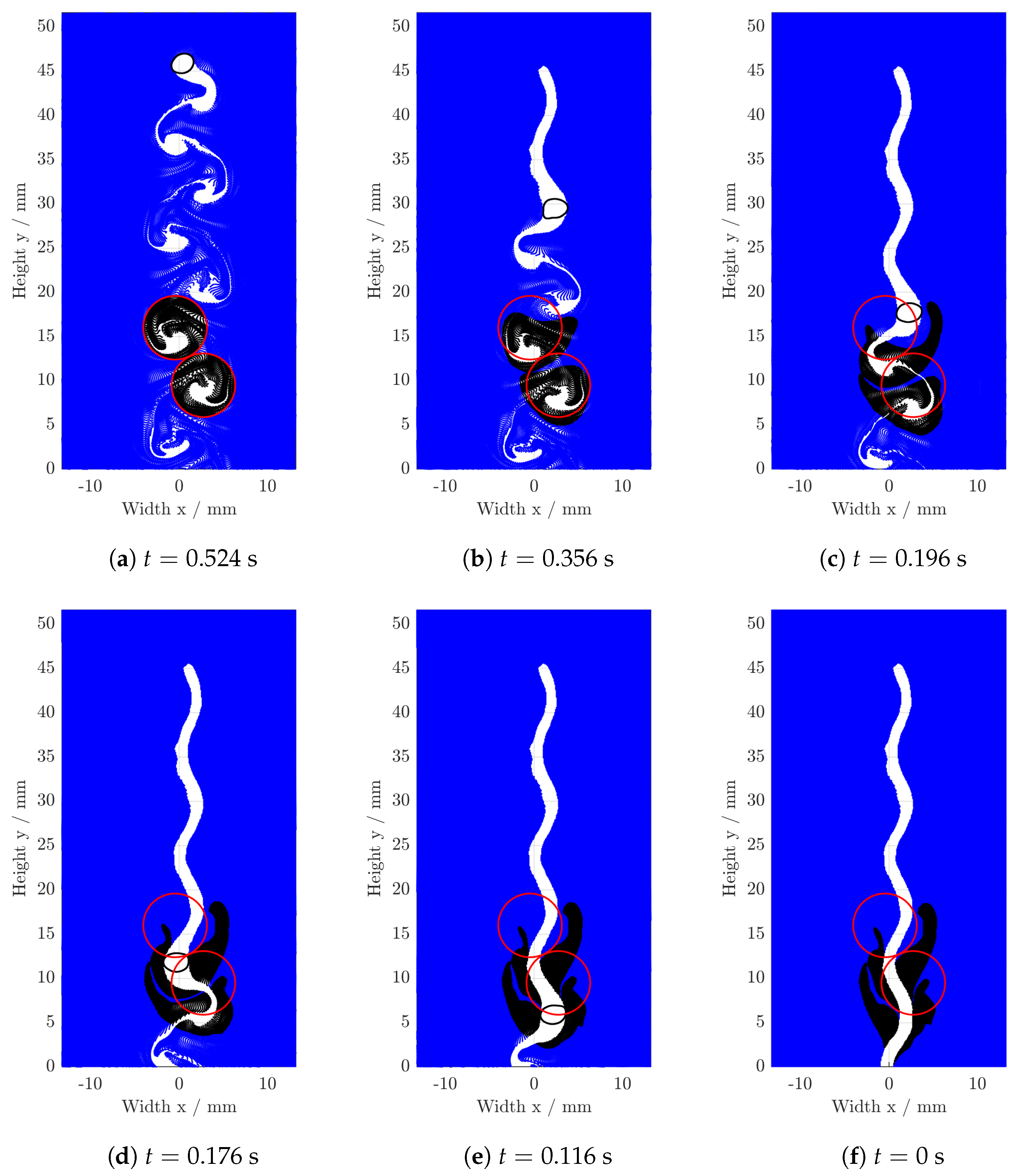

| Parameter | Wobbling (cf. Figure 4a) | Ellipsoidal (cf. Figure 4b) |
|---|---|---|
| d/mm | ||
| /mms | ||
| h/d/- | ||
| /- | 949 | 388 |
| /- | 1593 | 550 |
| /- | 0.0028 | 0.0048 |
Publisher’s Note: MDPI stays neutral with regard to jurisdictional claims in published maps and institutional affiliations. |
© 2022 by the authors. Licensee MDPI, Basel, Switzerland. This article is an open access article distributed under the terms and conditions of the Creative Commons Attribution (CC BY) license (https://creativecommons.org/licenses/by/4.0/).
Share and Cite
Kursula, L.; Kexel, F.; Fitschen, J.; Hoffmann, M.; Schlüter, M.; von Kameke, A. Unsteady Mass Transfer in Bubble Wakes Analyzed by Lagrangian Coherent Structures in a Flat-Bed Reactor. Processes 2022, 10, 2686. https://doi.org/10.3390/pr10122686
Kursula L, Kexel F, Fitschen J, Hoffmann M, Schlüter M, von Kameke A. Unsteady Mass Transfer in Bubble Wakes Analyzed by Lagrangian Coherent Structures in a Flat-Bed Reactor. Processes. 2022; 10(12):2686. https://doi.org/10.3390/pr10122686
Chicago/Turabian StyleKursula, Lotta, Felix Kexel, Jürgen Fitschen, Marko Hoffmann, Michael Schlüter, and Alexandra von Kameke. 2022. "Unsteady Mass Transfer in Bubble Wakes Analyzed by Lagrangian Coherent Structures in a Flat-Bed Reactor" Processes 10, no. 12: 2686. https://doi.org/10.3390/pr10122686
APA StyleKursula, L., Kexel, F., Fitschen, J., Hoffmann, M., Schlüter, M., & von Kameke, A. (2022). Unsteady Mass Transfer in Bubble Wakes Analyzed by Lagrangian Coherent Structures in a Flat-Bed Reactor. Processes, 10(12), 2686. https://doi.org/10.3390/pr10122686







